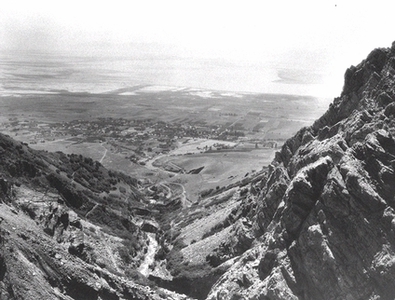WILLARD

Willard, 1937
Willard, the southernmost community in Box Elder County along U.S. 89, is nestled beneath majestic Willard peak in the mountains to the east. Seven miles north is Brigham City; and Ogden is thirteen miles to the south. To the west are salt flats and the fresh water Willard Bay, created in 1964.
Willard had its beginning in 1851, when several companies of settlers were sent out from Salt Lake City. Nineteen people located on North Willow Creek, seven miles south of where Brigham would soon be. Two years later, the settlement was moved to a better site, two miles farther south, and the name North Willow Creek was given to the new settlement. A fort wall was built to protect them from the threat of Indian attacks.
In the fall of 1851 North Willow Creek was surveyed by Henry G. Sherwood, assisted by Cyril Call. In 1859 it was renamed Willard in honor of Willard Richards, a recently-deceased Apostle of the Mormon church, and counselor to Brigham Young. Willard received her charter as a city in 1870. The town site encompasses seven square miles, being three and a half miles long and two miles wide.
Most of Willard's first settlers were mostly of Welsh, English, Scottish and Dutch descent. Most were farmers, but some were merchants, carpenters, blacksmiths and school teachers. Willard's inhabitants included an abundance of musicians. Willard has always been noted for its music, claiming Evan Stephens, Mormon Tabernacle Choir Director, and Robert J. Bird, hymn writer, among its "native sons".
Shadrack Jones was an especially gifted stone mason, and Willard's rock homes reflect his handiwork. Over thirty pioneer rock homes are still standing, many of which are on the National Register of Historic Places. A brick yard and the first grist mill in Box Elder County, as well as a number of molasses mills, provided for the first citizens' basic needs.
Electric power came to Willard in the early 1900s with completion of Willard's own power house. A water system was completed in 1912, utilizing water from Willard Canyon. By 1918, Willard was a station on the main line of the Oregon Short Line Railroad. The community had a canning factory, a money order post office, general stores, and an estimated population of 800, which was 200 more than Tremonton at that time. It was a city of the third class. Its population in the 1950 census was 1,298.
Historically, the economy of Willard centered around agriculture, with fruit crops being the major product. Colorful roadside fruit stands grace Highway 89 as it winds through the area. Buyers travel far to purchase the best fruit in the west along northern Utah's "fruit way."
The construction of Interstate 15 west of Willard eliminated many negative aspects of the "through" traffic on Highway 89 by reducing the noise level and minimizing the hazards of crossing the busy highway. It impacted the local economy by reducing sales at the fruit stands for awhile, but patrons have since returned in force, and sales are strong.
Agriculture is now a secondary source of income. Some businesses are located in Willard, but most people seek employment nearby. Hill Air Force Base, the Ogden Internal Revenue Service, Utah General Depot and Thiokol Corporation are within easy commuting distance and employ many citizens. The rural atmosphere and proximity to these facilities make Willard an ideal place to live and raise a family.
Willard is located on an alluvial fan exposed as Lake Bonneville receded and, as such, is an ideal spot for gravel pits: a mixed blessing to the town. Predominantly LDS, Willard has three wards housed in a new meeting house built in 1973. Willard and Perry now comprise an LDS stake of their own, the Willard Stake having been created 25 November 1984.
The new Willard Elementary School, built in 1986, is of modern energy-efficient design. At the time of its construction, the old school was demolished, however, its west wing, built in 1964, was left intact to serve as Willard's city hall. It houses the police, courts and offices. A modern post office was built in 1990. A large fire station was built in 1992, to house the volunteer fire department.
The sheer rock cliffs that rise so majestically east of Willard have, on several occasions, contributed to floods in the valley. The situation has been addressed by the Willard City/Box Elder County Drainage and Flood Control District, which installed reservoirs and pipe lines, helping greatly to reduce the flood problem. Young men in the Civilian Conservation Corps built the dike and spillway in the 1930s to alleviate some causes of the floods; their work also included terracing Willard basin in the upper canyon. With those measures, past concerns have been alleviated.
A trip to Willard Peak is rewarded with a breathtaking view of the valley below. During the early summer months, over twenty-eight varieties of colorful wild flowers may be seen blooming in profusion along the way. Willard itself it noted for its beautiful sunsets seen across the bay.
Willard claims the oldest continuous Fourth of July celebration in Utah It begins with a Firemen's Ball the night before, races and booths that day, and ending with fireworks in the Willow Creek park east of town.
Willard Bay State Park, located west of I-15, is a major recreational area for boating and camping. Its year-round fishing and close proximity to the population of the Wasatch Front makes it one of the most popular of Utah's state parks. Between January and October 1992, 269,232 people used its facilities.
Disclaimer: Information on this site was converted from a hard cover book published by University of Utah Press in 1994. Any errors should be directed towards the University of Utah Press.